1960s
A Jazz Lexicon
Pepper your speech with all these forgotten slang terms, and you will acquire an air of coolness and mystery.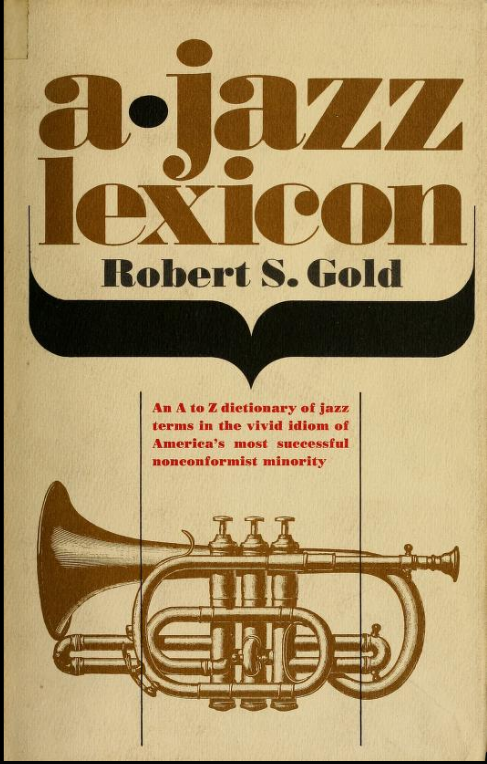
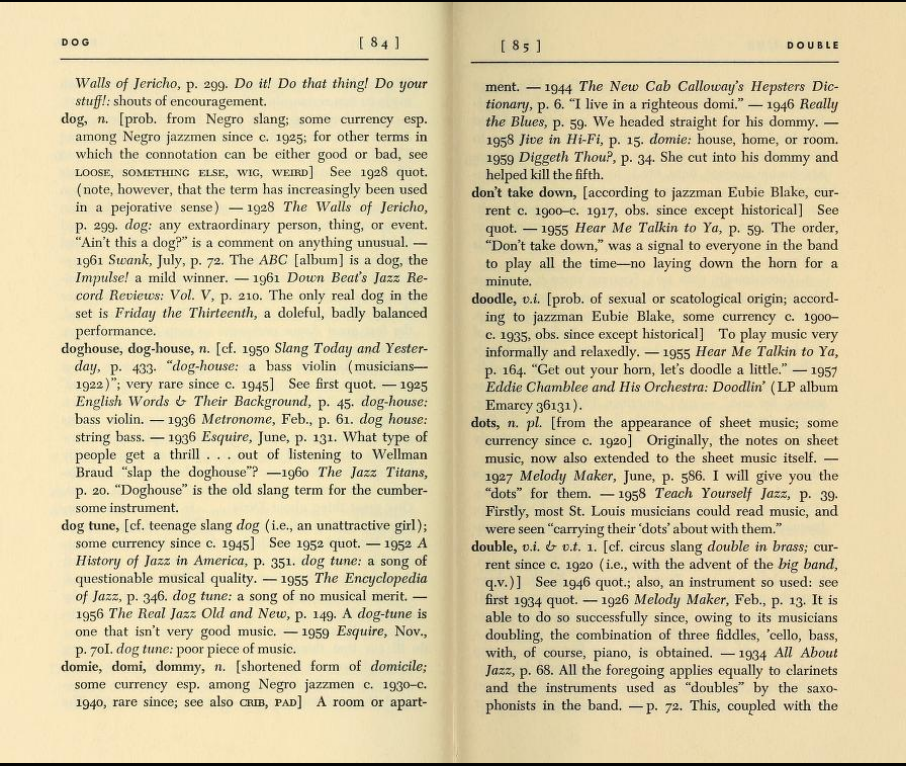
Posted By: Paul - Wed Dec 21, 2022 -
Comments (2)
Category: Music, Bohemians, Beatniks, Hippies and Slackers, 1960s, Slang
The woman who sued God and won
On Aug 17, 1960, Betty Penrose's house in Phoenix was hit by lightning. Nine years later she sued God for damages — and won. Kinda. Sorta. Technically, what she won was the right to summon God to a trial which (assuming God would be a no-show) would have resulted in a default judgement against the deity.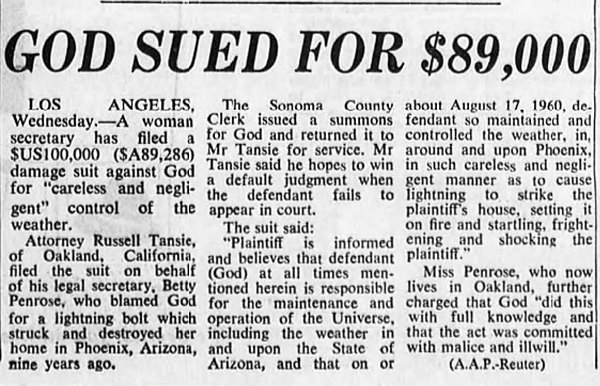
Sydney Morning Herald - May 15, 1969
Some additional context is necessary to understand Penrose's case.
Over in Sebastapol, California, singer Lou Gottlieb had been fighting the county government's attempt to shut down the hippie commune he had started on his Morning Star Ranch. As a legal maneuver to avoid paying the county's fines, Gottlieb deeded his land to God. Then he declared that the county could try collecting the fines from God.
This caused Phoenix attorney Russell Tansie, who was Penrose's employer, to realize that if God now legally owned property (the Morning Star Ranch), then God could be sued for damages. And that's how Penrose's suit emerged.
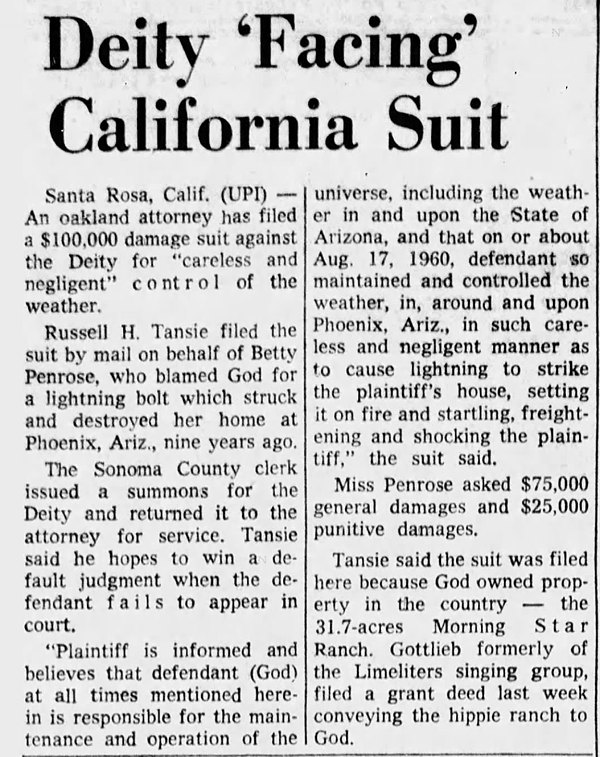
Indianapolis Star - May 14, 1969
However, I don't think Penrose's case ever made it to trial because, back in California, a judge had ruled that God, being neither a "natural or artificial person," could not legally own Gottlieb's ranch. So Gottlieb was still the owner and had to pay the fines.
And if God didn't own the ranch, then Penrose's case became moot.
But if Penrose's case had proceeded, it was possible God wouldn't have been a no-show. San Quentin prisoner Paul Yerkes Bechtel claimed to be God. So he might have appeared in court. And Joseph Njue of Kenya had also offered to defend God.
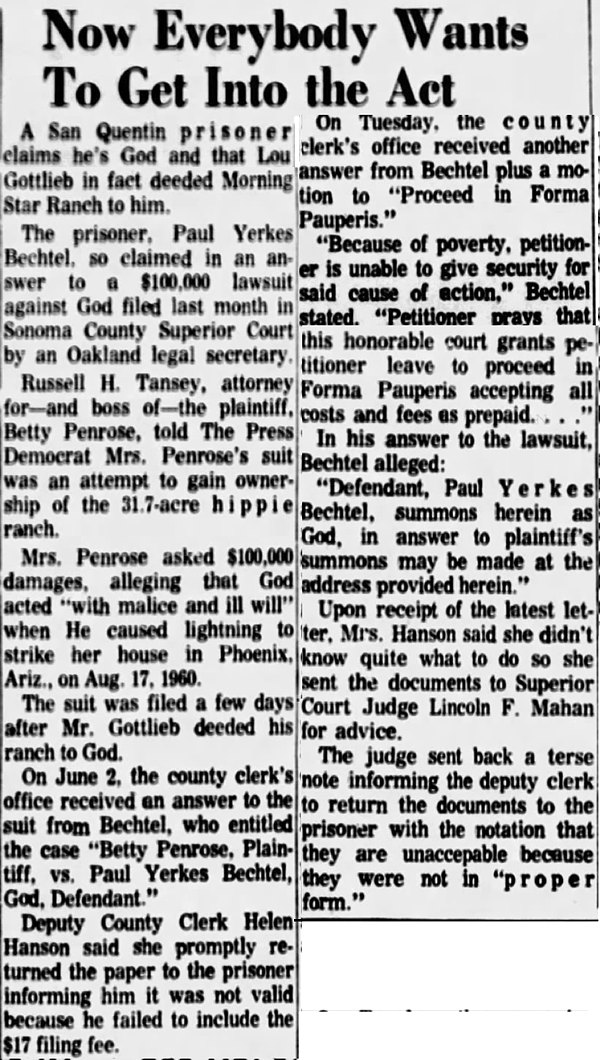
Santa Rosa Press Democrat - June 12, 1969
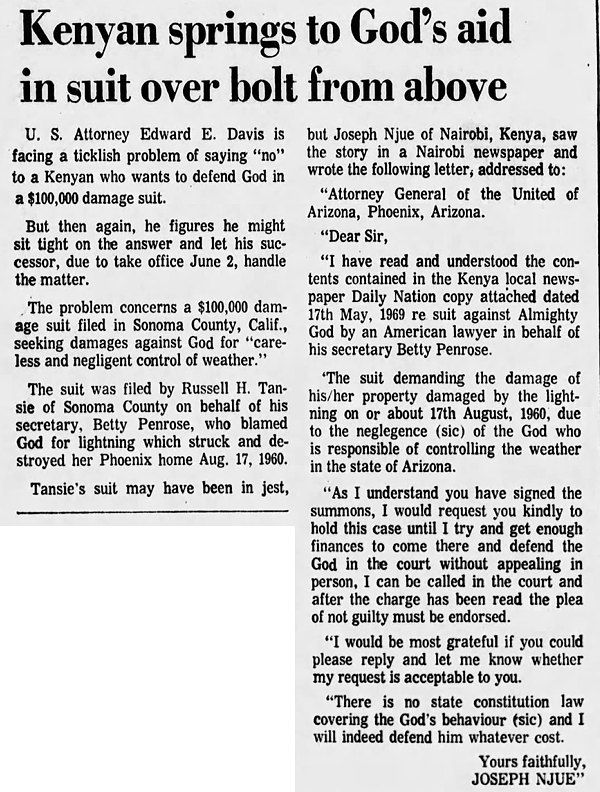
Arizona Republic - May 22, 1969
Posted By: Alex - Tue Dec 20, 2022 -
Comments (2)
Category: Religion, Lawsuits, 1960s, Arizona
The North Dakota Zap-In, 1969
May 1969: Responding to a suggestion in the North Dakota State University paper that students "Zip to Zap" to stage a "Zap-In" in Zap, North Dakota (population: 300), 3000 young people descended on the town. The Zap-In soon descended into chaos, prompting the mayor to summon the National Guard to remove the students.According to wikipedia, the event was "the only official riot in the history of North Dakota that was put down by the National Guard."
More info: Minot Daily News

Bismarck Tribune - May 10, 1969

Bismarck Tribune - Aug 7, 1969

Students gather around the bonfire built in the middle of Zap's Main Street
source: North Dakota Digital Horizons

The National Guard in Zap
source: North Dakota Historical Society
Posted By: Alex - Sat Dec 17, 2022 -
Comments (0)
Category: Dinners, Banquets, Parties, Tributes, Roasts and Other Celebrations, Riots, Protests and Civil Disobedience, 1960s
“The Mouse That Roared” Unsold Television Pilot
Posted By: Paul - Wed Dec 14, 2022 -
Comments (3)
Category: Movies, Television, Unlikely, Improbable and Counterfactual Phenomena, 1960s
Follies of the Madmen #549
Posted By: Paul - Tue Dec 13, 2022 -
Comments (0)
Category: Family, Newspapers, Restaurants, Advertising, Comics, Junk Food, 1960s
foew&ombwhnw
foew&ombwhnw, by Dick Higgins, was published in 1969 by Something Else Press. The title was an acronym for "freaked-out electronic wizards & other marvellous bartenders who have no wings."The design of the book was unusual. It was made to look like a prayer book, with black cover and thin pages. Inside, the text was divided into four columns. To read the book in order you had to first read all the left-hand columns, then all the second-to-left columns, etc.
The book itself was a collection of essays, plays, and poems. Or, as Higgins described it, "a grammar of the mind and a phenomenology of love and a science of the arts as seen by a stalker of the wild mushroom."
Copies of it generally go for over $100, for anyone interested in adding it to their collection of weird books.
More info: DickHiggins.org


source: printedmatter.org
Posted By: Alex - Sat Dec 10, 2022 -
Comments (0)
Category: Literature, Books, 1960s
The Mighty Tiny Phonograph
Real record players and real 45's were so prevalent and inexpensive, why would anyone invest in this?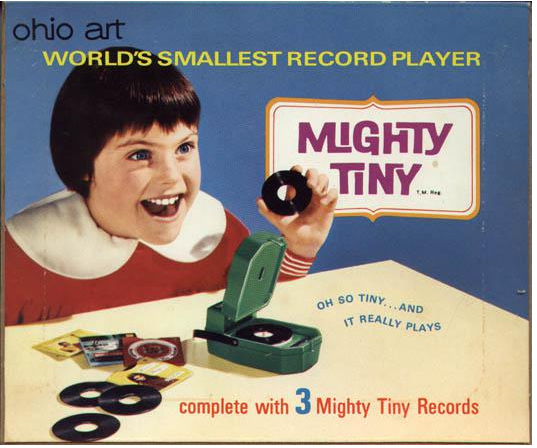
Posted By: Paul - Sat Dec 10, 2022 -
Comments (4)
Category: Toys, 1960s, Cacophony, Dissonance, White Noise and Other Sonic Assaults
Sodaburst Premade Ice Cream Soda
So much easier than 1) pouring a glass of soda and 2) scooping some ice cream into it. Completely eliminates the dreaded element of decision-making (which ice cream, which soda?).
Posted By: Paul - Sun Dec 04, 2022 -
Comments (0)
Category: Food, Soda, Pop, Soft Drinks and other Non-Alcoholic Beverages, Chindogu, 1960s
Beatnik Fly
Their Wikipedia page.
Posted By: Paul - Thu Dec 01, 2022 -
Comments (2)
Category: Insects and Spiders, Music, Gonzo, Demento, Kooky, Wacky and Out-there, 1950s, 1960s
Miss Formula
Miss Formula, who made her debut in 1964, was said to be "a computer's idea of how the perfect female should look." Though she was actually what the engineers at California Computer Products, Inc. thought the perfect female should look like. They designed her and the computer printed her out.California Computer Products (CalComp) was eventually acquired by the Lockheed Corporation. I wonder if Miss Formula still resides somewhere in their computer systems.
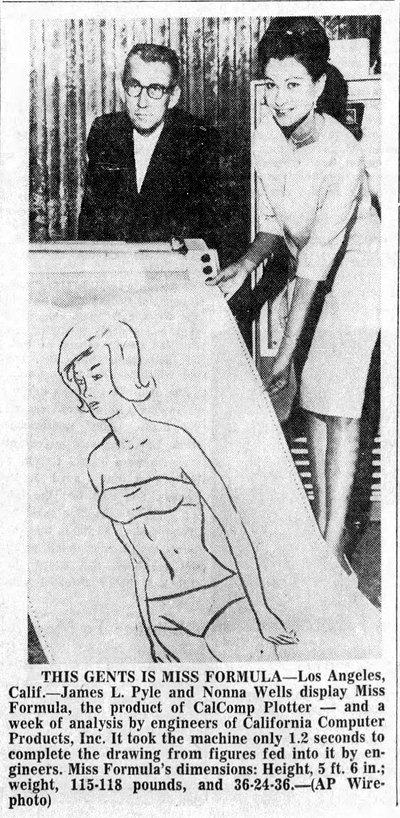
Tampa Tribune - July 31, 1964
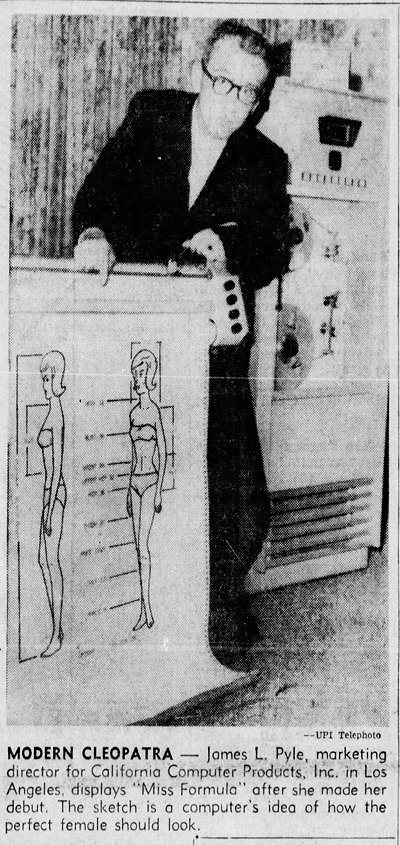
Pittsburgh Press - July 29, 1964

Pomona Progress-Bulletin - July 29, 1964
Posted By: Alex - Fri Nov 25, 2022 -
Comments (4)
Category: Awards, Prizes, Competitions and Contests, Technology, Computers, 1960s

| Who We Are |
|---|
| Alex Boese Alex is the creator and curator of the Museum of Hoaxes. He's also the author of various weird, non-fiction, science-themed books such as Elephants on Acid and Psychedelic Apes. Paul Di Filippo Paul has been paid to put weird ideas into fictional form for over thirty years, in his career as a noted science fiction writer. He has recently begun blogging on many curious topics with three fellow writers at The Inferior 4+1. Contact Us |




